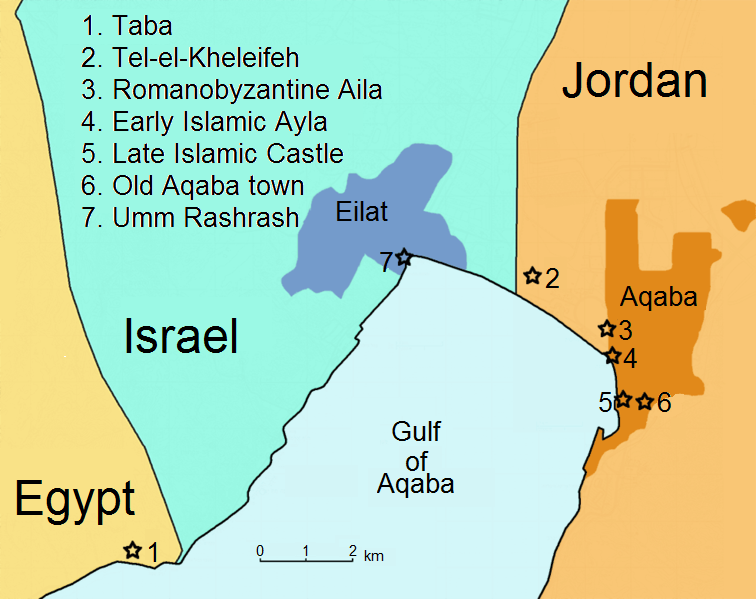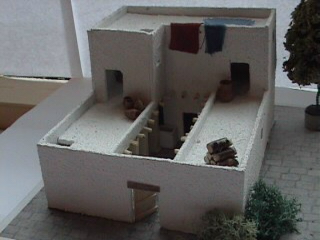|
Tell El-Kheleifeh
Tell el-Kheleifeh (also Tell el-Chulefi) is an archaeological site in Jordan at the head of the Gulf of Aqaba immediately northwest of the city of Aqaba. Its older identification with the 10th-century port from the Hebrew Bible, biblical King Solomon narrative does not stand up to newer archaeological assessments, while its identification with biblical Ezion-geber and/or Elath of a later date remains a matter of speculative interpretation.Pratico (1985)Finkelstein (2014) Archaeological field investigation During his excavations in 1933, the researcher Fritz Frank stated that he believed the ruins were those of Ezion-geber. During his excavations from 1938 to 1940, American archaeologist Nelson Glueck adopted the same thesis. He distinguished five settlement periods, which he dated to between the 10th and 5th centuries BCE. Periods In 1985, Gary Pratico presented a comprehensive reassessment of the architectural and ceramic finds. Particularly in the case of ceramics, he came to a ... [...More Info...] [...Related Items...] OR: [Wikipedia] [Google] [Baidu] |
Four-room Building
A four-room house, also known as an "Israelite house" or a "pillared house" is the name given to the mud and stone houses characteristic of the Iron Age of Levant. The four-room house is so named because its floor plan is divided into four sections, although not all four are proper rooms, one often being an unroofed courtyard. It is also sometimes called a pillared house because two—or all three—of the parallel ground-level "rooms" are separated by one—or two, respectively—rows of wooden pillars. The pillars, however, are not the defining feature of the four-room house, and this error of terminology leads to the confusion of four-room houses with other buildings, such as storehouses and stables, where pillars were widely used, but which were not constructed under the four-room house layout. When an upper floor was included, the inhabitants used it as living quarters, while the ground floor was used as a stable for livestock and for storage. There were multiple variation ... [...More Info...] [...Related Items...] OR: [Wikipedia] [Google] [Baidu] |
Ephraim Stern
Ephraim Stern ('';'' January 15, 1934 – March 23, 2018) was an Israeli archaeologist and professor at the Hebrew University of Jerusalem. He specialized in the archaeology of ancient Israel and Judah and Phoenicia,http://www.thebritishmuseum.ac.uk and was known for his excavations at (1980–2000). He received the EMET Prize in 2005. Early life and family Stern was born in in 1934. He graduated from the |
Michael Avi-Yonah
Michael Avi-Yonah (; September 26, 1904 – March 26, 1974) was an Israeli archaeologist and historian. During his career he was a Professor of Archaeology at the Hebrew University of Jerusalem and served as secretary of Israel's Department of Antiquities. Biography Born in Lemberg, Austria-Hungary (today Lviv, Ukraine), Avi-Yonah moved to Mandatory Palestine with his parents in 1919 during the Third Aliyah. He first studied at Gymnasia Rehavia in Jerusalem, then he went to England and studied history and archeology at the University of London. After returning to Jerusalem, he studied at the British School of Archaeology in Jerusalem. His first archaeological excavations were at Tel el-Ajjul near Gaza, and the Jerusalem Ophel. At the end of his studies, he joined the Department of Antiquities of the British government of Palestine. He worked as a librarian and archivist. After the independence of the state of Israel, he became secretary of the Department of Antiquities. I ... [...More Info...] [...Related Items...] OR: [Wikipedia] [Google] [Baidu] |
Tell (archaeology)
In archaeology, a tell (from , ', 'mound' or 'small hill') is an artificial topographical feature, a mound consisting of the accumulated and stratified debris of a succession of consecutive settlements at the same site, the refuse of generations of people who built and inhabited them and natural sediment. Tells are most commonly associated with the ancient Near East but are also found elsewhere, such as in Southern Europe, Southern and parts of Central Europe, from Greece and Bulgaria to Hungary and Spain,, see map. and in North Africa. Within the Near East they are concentrated in less arid regions, including Upper Mesopotamia, the Southern Levant, Anatolia and Iran, which had more continuous settlement. Eurasian tells date to the Neolithic, the Chalcolithic and the Bronze and Iron Ages. In the Southern Levant the time of the tells ended with the conquest by Alexander the Great, which ushered in the Hellenistic period with its own, different settlement-building patterns. Many t ... [...More Info...] [...Related Items...] OR: [Wikipedia] [Google] [Baidu] |
Achaemenid Empire
The Achaemenid Empire or Achaemenian Empire, also known as the Persian Empire or First Persian Empire (; , , ), was an Iranian peoples, Iranian empire founded by Cyrus the Great of the Achaemenid dynasty in 550 BC. Based in modern-day Iran, it was the List of largest empires#Timeline of largest empires to date, largest empire by that point in history, spanning a total of . The empire spanned from the Balkans and ancient Egypt, Egypt in the west, most of West Asia, the majority of Central Asia to the northeast, and the Indus Basin, Indus Valley of South Asia to the southeast. Around the 7th century BC, the region of Persis in the southwestern portion of the Iranian plateau was settled by the Persians. From Persis, Cyrus rose and defeated the Medes, Median Empire as well as Lydia and the Neo-Babylonian Empire, marking the establishment of a new imperial polity under the Achaemenid dynasty. In the modern era, the Achaemenid Empire has been recognised for its imposition of a succ ... [...More Info...] [...Related Items...] OR: [Wikipedia] [Google] [Baidu] |
Ostraca
An ostracon (Greek language, Greek: ''ostrakon'', plural ''ostraka'') is a piece of pottery, usually broken off from a vase or other earthenware vessel. In an archaeology, archaeological or epigraphy, epigraphical context, ''ostraca'' refer to sherds or even small pieces of stone that have writing scratched into them. Usually these are considered to have been broken off before the writing was added; ancient people used the cheap, plentiful, and durable broken pieces of pottery around them as a convenient medium to write on for a wide variety of purposes, mostly very short inscriptions, but in some cases very long. Ostracism In Classical Athens, when the decision at hand was to banish or exile a certain member of society, citizen peers would cast their vote by writing the name of the person on the shard of pottery; the vote was counted and, if unfavorable, the person was exiled for a period of ten years from the city, thus giving rise to the term ''ostracism''. Broken pottery ... [...More Info...] [...Related Items...] OR: [Wikipedia] [Google] [Baidu] |
Aramaic
Aramaic (; ) is a Northwest Semitic language that originated in the ancient region of Syria and quickly spread to Mesopotamia, the southern Levant, Sinai, southeastern Anatolia, and Eastern Arabia, where it has been continually written and spoken in different varieties for over three thousand years. Aramaic served as a language of public life and administration of ancient kingdoms and empires, particularly the Neo-Assyrian Empire, Neo-Babylonian Empire, and Achaemenid Empire, and also as a language of divine worship and religious study within Judaism, Christianity, and Gnosticism. Several modern varieties of Aramaic are still spoken. The modern eastern branch is spoken by Assyrians, Mandeans, and Mizrahi Jews.{{cite book , last1=Huehnergard , first1=John , author-link1=John Huehnergard , last2=Rubin , first2=Aaron D. , author-link2=Aaron D. Rubin , date=2011 , editor-last=Weninger , editor-first=Stefan , title=The Semitic Languages: An International Handbook , pub ... [...More Info...] [...Related Items...] OR: [Wikipedia] [Google] [Baidu] |
Khirbet En-Nahas
Khirbet en-Nahas, also spelled Khirbat en-Nahas, is one of the largest copper mining and smelting sites of the ancient world, built around 3,000 years ago. It is located in Wadi Faynan, between the Dead Sea and the Gulf of Aqaba, now in Jordan. There is evidence of sophisticated economic and political activity in the valley about 3,000 years ago and archaeologists think it may be the site of an early organized state. Archaeologist Thomas E. Levy of the University of California, San Diego, heads a dig at Khirbat en-Nahas that has uncovered an ancient copper mining operation on a scale that he says can have been organized by only "an ancient state or kingdom." Robert Draper, Kings of Controversy, National Geographic, December 2010. It is through the ground stone tools assemble ... [...More Info...] [...Related Items...] OR: [Wikipedia] [Google] [Baidu] |
Ein Hatzeva
Ein Hatzeva (, ''lit.'' Hatzeva Spring) is a moshav in the central Arabah, Arava valley in Israel. Located south of the Dead Sea, it falls under the jurisdiction of Tamar Regional Council. In 2019 it had a population of 50. Name Moshav Ein Hatzeva was named after the nearby Hatzeva Spring, which in turn takes its name from the Arabic name, Ayn Husb. The location was mentioned in Greek texts as Eisebon. Archaeology The holds remains of two Judahite fortresses, a Nabataeans , Nabataean caravanserai, and a Roman fort, part of the Limes Arabicus. It took advantage of the Spring of Hazeva (in Hebrew Ein Hazeva), a rare water source in the region. It is identified with the biblical site Tamar (). According to the Hebrew Bible, it was a Judahite site, but Edomite idols were also discovered there, now on display at the Israel Museum. In the Nabataean period, Hatzeva was a caravanserai along the northern path of the incense route. Later it became a Roman fort, part of the Roman chain of ... [...More Info...] [...Related Items...] OR: [Wikipedia] [Google] [Baidu] |
Neo-Assyrian Empire
The Neo-Assyrian Empire was the fourth and penultimate stage of ancient Assyrian history. Beginning with the accession of Adad-nirari II in 911 BC, the Neo-Assyrian Empire grew to dominate the ancient Near East and parts of South Caucasus, North Africa and East Mediterranean throughout much of the 9th to 7th centuries BC, becoming the List of largest empires, largest empire in history up to that point. Because of its geopolitical dominance and ideology based in world domination, the Neo-Assyrian Empire has been described as the first world empire in history. It influenced other empires of the ancient world culturally, administratively, and militarily, including the Neo-Babylonian Empire, Neo-Babylonians, the Achaemenid dynasty, Achaemenids, and the Seleucid Empire, Seleucids. At its height, the empire was the strongest military power in the world and ruled over all of Mesopotamia, the Levant and Egypt, as well as parts of Anatolia, Arabian Peninsula, Arabia and modern-day Ir ... [...More Info...] [...Related Items...] OR: [Wikipedia] [Google] [Baidu] |
Fortified Gateway
A fortified gateway is an element of a variety of fortified structures, such as a castle or city wall, walled town. Fortified gates or gateways appear in the Bronze Age and reach into the modern times. City gate Gatehouse ''Torburg'' In German language, German, a "Torburg", lit. "gate castle", is a relatively autonomous and heavily fortified gateway of a castle or town. Medieval castle gateways of this type usually have additional fortifications in front of them. A common form is the tower gateway (German: ''Turmtorburg''); a variant is the bastion gateway (German: ''Halbrundturmtorburg''). List of castles in Europe, They are common in Europe. Examples in Europe France Château du Sou in Lacenas Germany *Deutsches Tor (Metz), Deutsches Tor in Metz *Ehrentor, Eigelsteintorburg, Hahnentorburg, Kuniberts Tower, Schaafentor and Severin Gate in Cologne *Town fortifications of Erkelenz *Friedländer Tor in Neubrandenburg *Marching Gate and Bridge Gate in Aachen as well as Aach ... [...More Info...] [...Related Items...] OR: [Wikipedia] [Google] [Baidu] |







